Photography and Photographers
The Art of Hayley Newman
Below are some of the captioned images that artist Hayley Newman displayed at her first solo show, "Connotations - Performance Images 1994-98".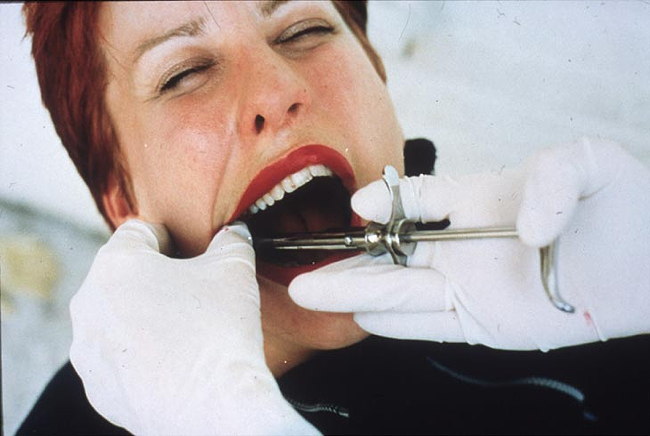
Lock-jaw Lecture Series (1997/1998)
"Over the period of a year I was invited to give a series of lectures on my work. Before each lecture I visited a local dentist and had my mouth anaesthetised. With my mouth made immobile, I gave my feeblest apologies to the students and staff before attempting to talk on my work."

B(in) (1996)
"Sitting in a bin bag waiting for bin men to pick me up in New York. When the bin men arrived at 4pm, I jumped out of the bag and ran home."

Crying Glasses (An Aid to Melancholia) - (1995)
"Over a year I wore the crying glasses while travelling on public transport in all the cities I visited. The glasses functioned using a pump system which, hidden inside my jacket allowed me to pump water up out of the glasses and produced a trickle of tears down my cheeks. The glasses were conceived as a tool to enable the representation of feelings in public spaces. Over the months of wearing the glasses they became an external mechanism which enabled the manifestation of internal and unidentifiable emotions."

Spirit (1995)
"Soho, London: Dressed as a ghost for Halloween I ran into various pubs in London's Soho, stole a drink and then left."
Here's the punchline, which Newman revealed if you read the fine print in the exhibit guide:
Image sources: Lock-jaw, Crying Glasses, B(in), Spirit
Posted By: Alex - Fri Jun 09, 2017 -
Comments (3)
Category: Art, Photography and Photographers, 1990s
Miss Photoflash
The first foto below is of the 1945 contest. Given that it was the "First Revue" of the sponsoring group, we can tentatively date it as the first such contest.
Original foto here.
The next foto is from 1968, and definitively labels the contest as being in its 24th year. Did it end then, amidst the tumult of the era?

Original foto here.
Here are the 1945 contestants again.

Posted By: Paul - Thu Feb 16, 2017 -
Comments (1)
Category: Beauty, Ugliness and Other Aesthetic Issues, Contests, Races and Other Competitions, Photography and Photographers, Regionalism, 1940s, 1950s, 1960s
Photographing a mule at the instant its head is blown off by dynamite
Advances in photographic technology that occurred in the 1860s and 70s led to the invention of plates that had exposure times of a fraction of a second. This allowed for "instantaneous photography," as it was called at the time. Moving objects could be frozen in time by the camera.Researchers immediately used this technology to study bodies in motion. Most famously, Eadweard Muybridge in 1878 took a series of images to study the galloping of a horse. Similarly, neurologist Jean-Martin Charcot used instantaneous photography to study the muscular movements of his human patients.
A more unusual application of the technology took place on June 6, 1881, when Mr. Van Sothen, photographer in charge at the United States School of Submarine Engineers in Willett's Point, New York, took an instantaneous photograph of a mule having its head blown off by dynamite. The mule was apparently old and was going to be put down anyway, so it was decided to "sacrifice the animal upon the altar of science."

The resulting photo
Eugene Griffin, First Lieutenant of Engineers, described the details of the experiment in a letter to Lieut. Col. H.L. Abbot:
Several months later Scientific American published an account of the experiment, including several engravings showing before and after scenes:
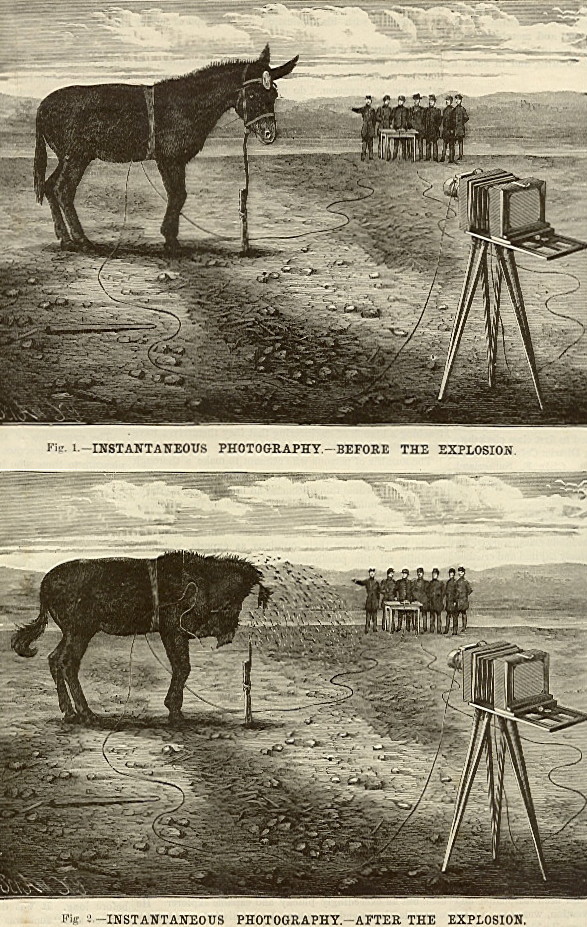
Scientific American - Sep 24, 1881
Posted By: Alex - Fri Sep 02, 2016 -
Comments (0)
Category: Mad Scientists, Evil Geniuses, Insane Villains, Photography and Photographers, Science, Experiments, Nineteenth Century
Auroratone
Auroratone was a "process for translating music into color" invented circa 1940 by Englishman Cecil Stokes. The music vibrated an emulsion of crystallizing chemicals, and this was then photographed by a color movie camera, producing a kind of psychedelic movie of shifting colors synchronized with music (but this was the 1940s, before the concept of psychedelics was known in popular culture).The hope was that these auroratone films could be used to treat psychiatric patients, and they were experimentally shown to soldiers in an army hospital suffering from psychotic depressions. Conclusion: "Observation revealed that these patients were intensely absorbed in the films, that their span of attention to the films was appreciably lengthened after exposure to the films. Weeping and sobbing was observed in some patients. Many patients became more accessible to individual and group psychotherapy immediately folllowing exposure to these films."
Their effect was also tested on juvenile delinquents. One kid told the experimenter, "I think God must have painted those pictures."
A company was formed to commercialize Auroratones and guide their development. Investors in this company included the Crosby Brothers (Larry and his famous brother Bing). Bing sang the music for many of the auroratones.
Treating psychiatric patients wasn't very profitable, so there was hope to find more lucrative applications of the auroratone process. One idea was to transfer auroratone color patterns onto textiles and ceramics. Some silk scarfs printed with visualizations of Bing Crosby singing "Home on the Range" were apparently manufactured, but never sold.
Not many auroratones still survive, but an example of one can be viewed on YouTube:
The auroratone process reminds me of the Clavilux (or Color Organ) invented by Thomas Wilfred in 1919 (previously posted about here).
More info about auroratones: Wikipedia and Milwaukee Journal, Dec 6, 1948.
Also see: Rubin, HE & Katz, E. (Oct 1946). "Auroratone films for the treatment of psychotic depressions in an army general hospital," Journal of Clinical Psychology, 2(4): 333-340.
Posted By: Alex - Thu Sep 03, 2015 -
Comments (9)
Category: Movies, Photography and Photographers, Psychology, 1940s
Cruise Ship Photos
Flashbak.com has posted an interesting collection of photos (titled "Love Boat Rejects") taken by official photographers aboard American, Norwegian, and Italian cruiseships during the 1990s. Check out the full gallery here.
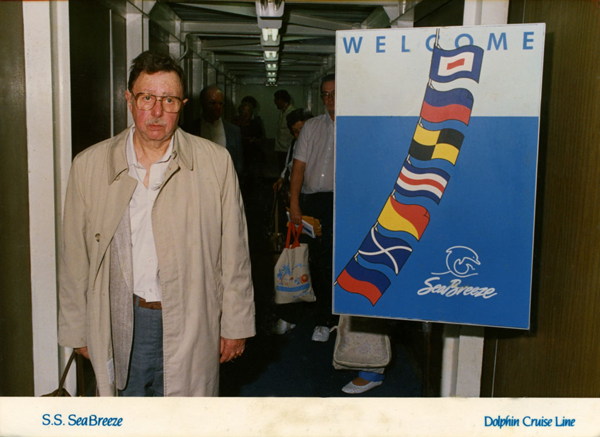

Posted By: Alex - Wed Aug 12, 2015 -
Comments (5)
Category: Photography and Photographers, 1990s
Satanic cloud above Statue of Liberty
Over at about.com, in honor of the Fourth of July, I just posted The 10 Weirdest Moments in the History of the Statue of Liberty, one of those moments being the time in 1989 (or maybe it was 1990 - sources differ), when two Irish tourists on vacation in NYC took a photo of Lady Liberty. It was only when they got back home and developed the photo that they noticed a "Satanic face" in the clouds leering down at her. I'll let you decide for yourself what meaning, if any, this might have. But as far as cloud photos go, it's a pretty famous one.Also, Happy Fourth of July!

Posted By: Alex - Sat Jul 04, 2015 -
Comments (12)
Category: Photography and Photographers, 1980s
Things Stuck On Face
Brazilian artist Edu Monteiro photographs himself with things stuck on his face. Things such as an octopus, lycra and polystyrene, or a container of dirt. Explore more of his "self transformations" at his website: edumonteiro.com.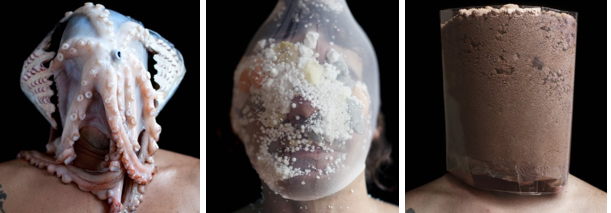
via Yahoo! News
Posted By: Alex - Thu Jun 11, 2015 -
Comments (4)
Category: Costumes and Masks, Photography and Photographers
Slop Bucket Art
Art is where you find it. Photographer Alyssa Blumstein has found it at the bottom of a New York restaurant's slop bucket. She uploads pictures of the slop bucket's contents to a Tumblr page, where it's now attracting a following.


via Junk Culture
Posted By: Alex - Sun May 10, 2015 -
Comments (4)
Category: Art, Photography and Photographers
The Selfie Arm
Created by artists Justin Crowe and Aric Snee who describe it as a "sarcastic solution to a quintessential problem — nobody wants to look alone while they mindlessly snap pictures of themselves." The stick is shaped like an arm, so in the pictures it looks like you're holding someone's hand.
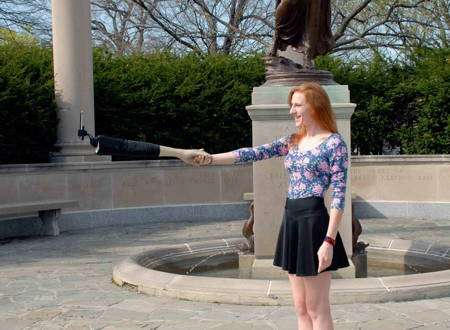
Posted By: Alex - Wed Apr 29, 2015 -
Comments (7)
Category: Photography and Photographers
Kearton’s Imitation Ox
Find more info about Kearton and his ox here.



Posted By: Alex - Sun Apr 19, 2015 -
Comments (5)
Category: Photography and Photographers, 1900s

| Who We Are |
|---|
| Alex Boese Alex is the creator and curator of the Museum of Hoaxes. He's also the author of various weird, non-fiction, science-themed books such as Elephants on Acid and Psychedelic Apes. Paul Di Filippo Paul has been paid to put weird ideas into fictional form for over thirty years, in his career as a noted science fiction writer. He has recently begun blogging on many curious topics with three fellow writers at The Inferior 4+1. Contact Us |




